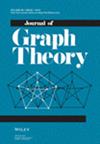求助PDF
{"title":"三角形连接有符号图上的整数流","authors":"Liangchen Li, Chong Li, Rong Luo, Cun-Quan Zhang","doi":"10.1002/jgt.23076","DOIUrl":null,"url":null,"abstract":"<p>A triangle-path in a graph <span></span><math>\n <semantics>\n <mrow>\n <mi>G</mi>\n </mrow>\n <annotation> $G$</annotation>\n </semantics></math> is a sequence of distinct triangles <span></span><math>\n <semantics>\n <mrow>\n <msub>\n <mi>T</mi>\n \n <mn>1</mn>\n </msub>\n \n <mo>,</mo>\n \n <msub>\n <mi>T</mi>\n \n <mn>2</mn>\n </msub>\n \n <mo>,</mo>\n \n <mi>…</mi>\n \n <mo>,</mo>\n \n <msub>\n <mi>T</mi>\n \n <mi>m</mi>\n </msub>\n </mrow>\n <annotation> ${T}_{1},{T}_{2},\\ldots ,{T}_{m}$</annotation>\n </semantics></math> in <span></span><math>\n <semantics>\n <mrow>\n <mi>G</mi>\n </mrow>\n <annotation> $G$</annotation>\n </semantics></math> such that for any <span></span><math>\n <semantics>\n <mrow>\n <mi>i</mi>\n \n <mo>,</mo>\n \n <mi>j</mi>\n </mrow>\n <annotation> $i,j$</annotation>\n </semantics></math> with <span></span><math>\n <semantics>\n <mrow>\n <mn>1</mn>\n \n <mo>≤</mo>\n \n <mi>i</mi>\n \n <mo><</mo>\n \n <mi>j</mi>\n \n <mo>≤</mo>\n \n <mi>m</mi>\n </mrow>\n <annotation> $1\\le i\\lt j\\le m$</annotation>\n </semantics></math>, <span></span><math>\n <semantics>\n <mrow>\n <mo>∣</mo>\n \n <mi>E</mi>\n <mrow>\n <mo>(</mo>\n \n <msub>\n <mi>T</mi>\n \n <mi>i</mi>\n </msub>\n \n <mo>)</mo>\n </mrow>\n \n <mo>∩</mo>\n \n <mi>E</mi>\n <mrow>\n <mo>(</mo>\n \n <msub>\n <mi>T</mi>\n <mrow>\n <mi>i</mi>\n \n <mo>+</mo>\n \n <mn>1</mn>\n </mrow>\n </msub>\n \n <mo>)</mo>\n </mrow>\n \n <mo>∣</mo>\n \n <mo>=</mo>\n \n <mn>1</mn>\n </mrow>\n <annotation> $| E({T}_{i})\\cap E({T}_{i+1})| =1$</annotation>\n </semantics></math> and <span></span><math>\n <semantics>\n <mrow>\n <mi>E</mi>\n <mrow>\n <mo>(</mo>\n \n <msub>\n <mi>T</mi>\n \n <mi>i</mi>\n </msub>\n \n <mo>)</mo>\n </mrow>\n \n <mo>∩</mo>\n \n <mi>E</mi>\n <mrow>\n <mo>(</mo>\n \n <msub>\n <mi>T</mi>\n \n <mi>j</mi>\n </msub>\n \n <mo>)</mo>\n </mrow>\n \n <mo>=</mo>\n \n <mi>∅</mi>\n </mrow>\n <annotation> $E({T}_{i})\\cap E({T}_{j})=\\varnothing $</annotation>\n </semantics></math> if <span></span><math>\n <semantics>\n <mrow>\n <mi>j</mi>\n \n <mo>></mo>\n \n <mi>i</mi>\n \n <mo>+</mo>\n \n <mn>1</mn>\n </mrow>\n <annotation> $j\\gt i+1$</annotation>\n </semantics></math>. A connected graph <span></span><math>\n <semantics>\n <mrow>\n <mi>G</mi>\n </mrow>\n <annotation> $G$</annotation>\n </semantics></math> is triangularly connected if for any two nonparallel edges <span></span><math>\n <semantics>\n <mrow>\n <mi>e</mi>\n </mrow>\n <annotation> $e$</annotation>\n </semantics></math> and <span></span><math>\n <semantics>\n <mrow>\n <mi>e</mi>\n \n <mo>′</mo>\n </mrow>\n <annotation> $e^{\\prime} $</annotation>\n </semantics></math> there is a triangle-path <span></span><math>\n <semantics>\n <mrow>\n <msub>\n <mi>T</mi>\n \n <mn>1</mn>\n </msub>\n \n <msub>\n <mi>T</mi>\n \n <mn>2</mn>\n </msub>\n \n <mi>⋯</mi>\n \n <msub>\n <mi>T</mi>\n \n <mi>m</mi>\n </msub>\n </mrow>\n <annotation> ${T}_{1}{T}_{2}\\cdots {T}_{m}$</annotation>\n </semantics></math> such that <span></span><math>\n <semantics>\n <mrow>\n <mi>e</mi>\n \n <mo>∈</mo>\n \n <mi>E</mi>\n <mrow>\n <mo>(</mo>\n \n <msub>\n <mi>T</mi>\n \n <mn>1</mn>\n </msub>\n \n <mo>)</mo>\n </mrow>\n </mrow>\n <annotation> $e\\in E({T}_{1})$</annotation>\n </semantics></math> and <span></span><math>\n <semantics>\n <mrow>\n <mi>e</mi>\n \n <mo>′</mo>\n \n <mo>∈</mo>\n \n <mi>E</mi>\n <mrow>\n <mo>(</mo>\n \n <msub>\n <mi>T</mi>\n \n <mi>m</mi>\n </msub>\n \n <mo>)</mo>\n </mrow>\n </mrow>\n <annotation> $e^{\\prime} \\in E({T}_{m})$</annotation>\n </semantics></math>. For ordinary graphs, Fan et al. characterize all triangularly connected graphs that admit nowhere-zero 3-flows or 4-flows. Corollaries of this result include the integer flow of some families of ordinary graphs, such as locally connected graphs due to Lai and some types of products of graphs due to Imrich et al. In this paper, Fan's result for triangularly connected graphs is further extended to signed graphs. We proved that a flow-admissible triangularly connected signed graph admits a nowhere-zero 4-flow if and only if it is not the wheel <span></span><math>\n <semantics>\n <mrow>\n <msub>\n <mi>W</mi>\n \n <mn>5</mn>\n </msub>\n </mrow>\n <annotation> ${W}_{5}$</annotation>\n </semantics></math> associated with a specific signature. Moreover, this result is sharp since there are infinitely many unbalanced triangularly connected signed graphs admitting a nowhere-zero 4-flow but no 3-flow.</p>","PeriodicalId":16014,"journal":{"name":"Journal of Graph Theory","volume":"106 2","pages":"257-272"},"PeriodicalIF":0.9000,"publicationDate":"2024-02-08","publicationTypes":"Journal Article","fieldsOfStudy":null,"isOpenAccess":false,"openAccessPdf":"","citationCount":"0","resultStr":"{\"title\":\"Integer flows on triangularly connected signed graphs\",\"authors\":\"Liangchen Li, Chong Li, Rong Luo, Cun-Quan Zhang\",\"doi\":\"10.1002/jgt.23076\",\"DOIUrl\":null,\"url\":null,\"abstract\":\"<p>A triangle-path in a graph <span></span><math>\\n <semantics>\\n <mrow>\\n <mi>G</mi>\\n </mrow>\\n <annotation> $G$</annotation>\\n </semantics></math> is a sequence of distinct triangles <span></span><math>\\n <semantics>\\n <mrow>\\n <msub>\\n <mi>T</mi>\\n \\n <mn>1</mn>\\n </msub>\\n \\n <mo>,</mo>\\n \\n <msub>\\n <mi>T</mi>\\n \\n <mn>2</mn>\\n </msub>\\n \\n <mo>,</mo>\\n \\n <mi>…</mi>\\n \\n <mo>,</mo>\\n \\n <msub>\\n <mi>T</mi>\\n \\n <mi>m</mi>\\n </msub>\\n </mrow>\\n <annotation> ${T}_{1},{T}_{2},\\\\ldots ,{T}_{m}$</annotation>\\n </semantics></math> in <span></span><math>\\n <semantics>\\n <mrow>\\n <mi>G</mi>\\n </mrow>\\n <annotation> $G$</annotation>\\n </semantics></math> such that for any <span></span><math>\\n <semantics>\\n <mrow>\\n <mi>i</mi>\\n \\n <mo>,</mo>\\n \\n <mi>j</mi>\\n </mrow>\\n <annotation> $i,j$</annotation>\\n </semantics></math> with <span></span><math>\\n <semantics>\\n <mrow>\\n <mn>1</mn>\\n \\n <mo>≤</mo>\\n \\n <mi>i</mi>\\n \\n <mo><</mo>\\n \\n <mi>j</mi>\\n \\n <mo>≤</mo>\\n \\n <mi>m</mi>\\n </mrow>\\n <annotation> $1\\\\le i\\\\lt j\\\\le m$</annotation>\\n </semantics></math>, <span></span><math>\\n <semantics>\\n <mrow>\\n <mo>∣</mo>\\n \\n <mi>E</mi>\\n <mrow>\\n <mo>(</mo>\\n \\n <msub>\\n <mi>T</mi>\\n \\n <mi>i</mi>\\n </msub>\\n \\n <mo>)</mo>\\n </mrow>\\n \\n <mo>∩</mo>\\n \\n <mi>E</mi>\\n <mrow>\\n <mo>(</mo>\\n \\n <msub>\\n <mi>T</mi>\\n <mrow>\\n <mi>i</mi>\\n \\n <mo>+</mo>\\n \\n <mn>1</mn>\\n </mrow>\\n </msub>\\n \\n <mo>)</mo>\\n </mrow>\\n \\n <mo>∣</mo>\\n \\n <mo>=</mo>\\n \\n <mn>1</mn>\\n </mrow>\\n <annotation> $| E({T}_{i})\\\\cap E({T}_{i+1})| =1$</annotation>\\n </semantics></math> and <span></span><math>\\n <semantics>\\n <mrow>\\n <mi>E</mi>\\n <mrow>\\n <mo>(</mo>\\n \\n <msub>\\n <mi>T</mi>\\n \\n <mi>i</mi>\\n </msub>\\n \\n <mo>)</mo>\\n </mrow>\\n \\n <mo>∩</mo>\\n \\n <mi>E</mi>\\n <mrow>\\n <mo>(</mo>\\n \\n <msub>\\n <mi>T</mi>\\n \\n <mi>j</mi>\\n </msub>\\n \\n <mo>)</mo>\\n </mrow>\\n \\n <mo>=</mo>\\n \\n <mi>∅</mi>\\n </mrow>\\n <annotation> $E({T}_{i})\\\\cap E({T}_{j})=\\\\varnothing $</annotation>\\n </semantics></math> if <span></span><math>\\n <semantics>\\n <mrow>\\n <mi>j</mi>\\n \\n <mo>></mo>\\n \\n <mi>i</mi>\\n \\n <mo>+</mo>\\n \\n <mn>1</mn>\\n </mrow>\\n <annotation> $j\\\\gt i+1$</annotation>\\n </semantics></math>. A connected graph <span></span><math>\\n <semantics>\\n <mrow>\\n <mi>G</mi>\\n </mrow>\\n <annotation> $G$</annotation>\\n </semantics></math> is triangularly connected if for any two nonparallel edges <span></span><math>\\n <semantics>\\n <mrow>\\n <mi>e</mi>\\n </mrow>\\n <annotation> $e$</annotation>\\n </semantics></math> and <span></span><math>\\n <semantics>\\n <mrow>\\n <mi>e</mi>\\n \\n <mo>′</mo>\\n </mrow>\\n <annotation> $e^{\\\\prime} $</annotation>\\n </semantics></math> there is a triangle-path <span></span><math>\\n <semantics>\\n <mrow>\\n <msub>\\n <mi>T</mi>\\n \\n <mn>1</mn>\\n </msub>\\n \\n <msub>\\n <mi>T</mi>\\n \\n <mn>2</mn>\\n </msub>\\n \\n <mi>⋯</mi>\\n \\n <msub>\\n <mi>T</mi>\\n \\n <mi>m</mi>\\n </msub>\\n </mrow>\\n <annotation> ${T}_{1}{T}_{2}\\\\cdots {T}_{m}$</annotation>\\n </semantics></math> such that <span></span><math>\\n <semantics>\\n <mrow>\\n <mi>e</mi>\\n \\n <mo>∈</mo>\\n \\n <mi>E</mi>\\n <mrow>\\n <mo>(</mo>\\n \\n <msub>\\n <mi>T</mi>\\n \\n <mn>1</mn>\\n </msub>\\n \\n <mo>)</mo>\\n </mrow>\\n </mrow>\\n <annotation> $e\\\\in E({T}_{1})$</annotation>\\n </semantics></math> and <span></span><math>\\n <semantics>\\n <mrow>\\n <mi>e</mi>\\n \\n <mo>′</mo>\\n \\n <mo>∈</mo>\\n \\n <mi>E</mi>\\n <mrow>\\n <mo>(</mo>\\n \\n <msub>\\n <mi>T</mi>\\n \\n <mi>m</mi>\\n </msub>\\n \\n <mo>)</mo>\\n </mrow>\\n </mrow>\\n <annotation> $e^{\\\\prime} \\\\in E({T}_{m})$</annotation>\\n </semantics></math>. For ordinary graphs, Fan et al. characterize all triangularly connected graphs that admit nowhere-zero 3-flows or 4-flows. Corollaries of this result include the integer flow of some families of ordinary graphs, such as locally connected graphs due to Lai and some types of products of graphs due to Imrich et al. In this paper, Fan's result for triangularly connected graphs is further extended to signed graphs. We proved that a flow-admissible triangularly connected signed graph admits a nowhere-zero 4-flow if and only if it is not the wheel <span></span><math>\\n <semantics>\\n <mrow>\\n <msub>\\n <mi>W</mi>\\n \\n <mn>5</mn>\\n </msub>\\n </mrow>\\n <annotation> ${W}_{5}$</annotation>\\n </semantics></math> associated with a specific signature. Moreover, this result is sharp since there are infinitely many unbalanced triangularly connected signed graphs admitting a nowhere-zero 4-flow but no 3-flow.</p>\",\"PeriodicalId\":16014,\"journal\":{\"name\":\"Journal of Graph Theory\",\"volume\":\"106 2\",\"pages\":\"257-272\"},\"PeriodicalIF\":0.9000,\"publicationDate\":\"2024-02-08\",\"publicationTypes\":\"Journal Article\",\"fieldsOfStudy\":null,\"isOpenAccess\":false,\"openAccessPdf\":\"\",\"citationCount\":\"0\",\"resultStr\":null,\"platform\":\"Semanticscholar\",\"paperid\":null,\"PeriodicalName\":\"Journal of Graph Theory\",\"FirstCategoryId\":\"100\",\"ListUrlMain\":\"https://onlinelibrary.wiley.com/doi/10.1002/jgt.23076\",\"RegionNum\":3,\"RegionCategory\":\"数学\",\"ArticlePicture\":[],\"TitleCN\":null,\"AbstractTextCN\":null,\"PMCID\":null,\"EPubDate\":\"\",\"PubModel\":\"\",\"JCR\":\"Q2\",\"JCRName\":\"MATHEMATICS\",\"Score\":null,\"Total\":0}","platform":"Semanticscholar","paperid":null,"PeriodicalName":"Journal of Graph Theory","FirstCategoryId":"100","ListUrlMain":"https://onlinelibrary.wiley.com/doi/10.1002/jgt.23076","RegionNum":3,"RegionCategory":"数学","ArticlePicture":[],"TitleCN":null,"AbstractTextCN":null,"PMCID":null,"EPubDate":"","PubModel":"","JCR":"Q2","JCRName":"MATHEMATICS","Score":null,"Total":0}
引用次数: 0
引用
批量引用

 求助内容:
求助内容: 应助结果提醒方式:
应助结果提醒方式:


